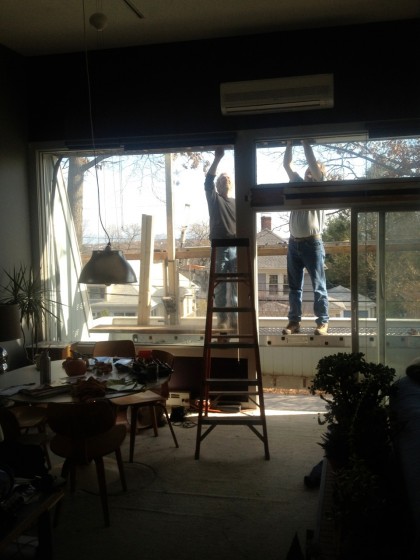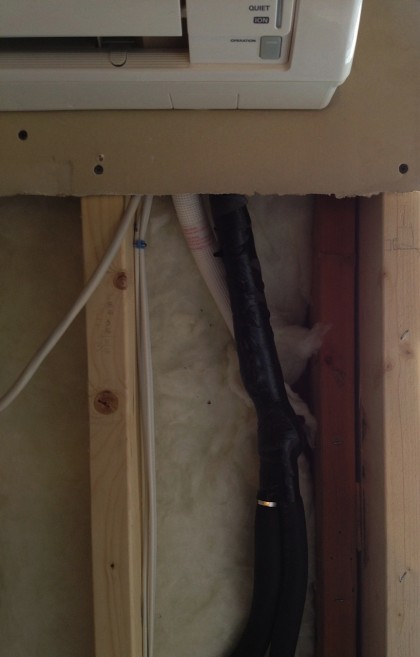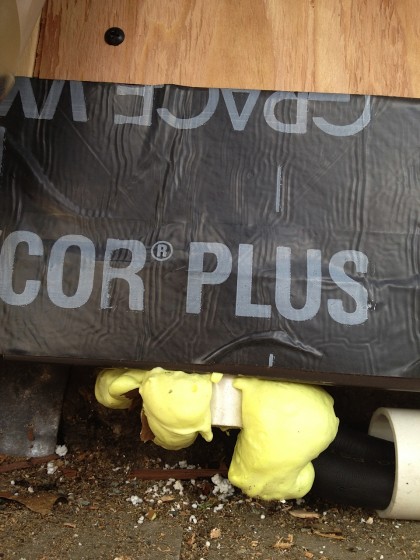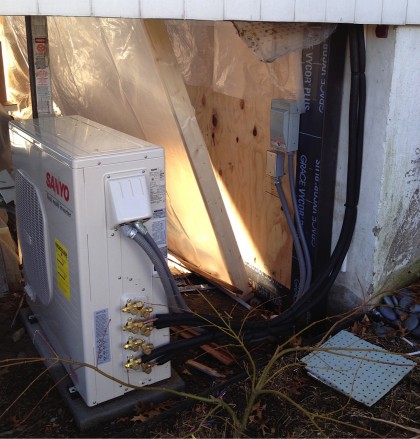Let’s talk briefly about how we’re going to heat our house. Currently, we have electric baseboard heat. It’s actually fairly efficient — it converts about 95% of the electricity into heat. But we’re investing in something even more efficient — and, key to a small house like ours, it allows us to use all the wall space that’s currently taken up with heaters.
So what is this wonder of which I speak? Officially known as an air-source heat pump, you may have heard it called a “mini-split.” Chances are you’ve seen one as the A/C-only units are popular in restaurants. This is the Sanyo unit we’ll be using (comes with a handy-dandy remote)…
If you want a really good explanation of why it’s more energy efficient, you should read this. So our new heat pump was installed a few days ago…
With some aesthetic changes and the elimination of the dark purple paint, eventually that mildly unattractive white rectangle above the window will disappear from view. We hope.
There are two refrigerant lines, the electric cable and a small PVC drain line for any condensation that forms in the summer or in winter when the unit is in defrost mode. The connections run down inside the double wall…
The hoses exit outside where they travel inside a piece of PVC over to the compressor…
I’ll clean up that expanding foam and seal a piece of metal flashing over the hole to maintain our water and air infiltration integrity, and to keep out 4- and 6-legged vermin.
An outside unit (the compressor) takes heat out of the air and pumps it into refrigerant which is circulated through pipes to the indoor unit (in summer the process is reversed)…
The compressor is relatively small considering it provides 32,000 BTUs of heat — and 34,000 BTUs of cooling. It can support up to four connections. We’ll be using just two: a 9,000 BTU unit downstairs and a 24,000 BTU unit in the upstairs living area. Each is connected to the compressor with two copper refrigerant lines wrapped in black foam insulation, and a 3-wire cable carrying electricity to the fans in the inside unit. The wire also carries signals from the inside units back to the compressor telling it whether to send heat or cooling, and how much to send. The compressor has a variable-speed DC motor which can run faster or slower as needed to suit demand. This makes it much more efficient than a simple on/off compressor.
Now that our electrician has made all the wiring connections, RAM Mechanical (our HVAC installer extraordinaire) will return to double-check the refrigerant connections for leaks. Before they left, they filled the hoses with nitrogen under pressure. If the pressure has dropped over the last week they’ll know something is amiss. Hopefully this is just a precaution and later this week we’ll have heat! In a month or two we’ll compare our past electric bills to the current ones and know just what we’re saving with the new system.
Tags: energy efficiency, hvac





will the hot air stay up in your high ceiling if the heat source is up that high? or do you have plans for ceiling fans, too?
ceiling fan definitely in the works. as well as a super-efficient wood stove with a blower of its own. will eventually be toasty in the winter with very little effort. we hope.
These types of units are super popular in Hong Kong, my apartment has one.
[…] you’ve been following along, the new heat was installed a week or so ago. Then came time to get it running. Jeff from RAM Mechanical came back to commission the HVAC […]
I like the original thermostat more than the new one, but the new one has obvious advantages (and I don’t mean joyful battery replacing…)
Be careful where you leave the remote. Someone left ours (we have the same one at the theater) on the cash register, which was warm, on a cold day. Yadda yadda yadda, nobody could understand why the AC kept kicking on when it was so chilly in there.
Be careful where you leave the remote!
i am never a huge fan of remotes but i don’t see how else we’d reach the units since they’re up high. probably a good idea to attach them to the wall, eh? so you’re saying don’t leave the remote in the freezer, then?
…or in the sun, or by the woodstove, or under a warm incandescent lamp, or behind the freezer…. Anywhere there is a “micro climate”.